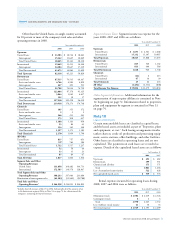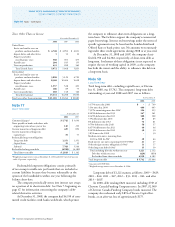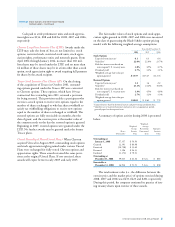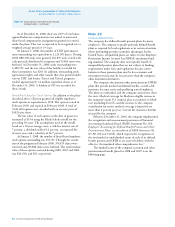Chevron 2008 Annual Report Download - page 81
Download and view the complete annual report
Please find page 81 of the 2008 Chevron annual report below. You can navigate through the pages in the report by either clicking on the pages listed below, or by using the keyword search tool below to find specific information within the annual report.
Chevron Corporation 2008 Annual Report 79
Note 19
New Accounting Standards
FASB Statement No. 141 (revised 2007), Business Combina-
tions (FAS 141-R) In December 2007, the FASB issued FAS
141-R, which became effective for business combination
transactions having an acquisition date on or after January 1,
2009. This standard requires the acquiring entity in a business
combination to recognize the assets acquired, the liabilities
assumed, and any noncontrolling interest in the acquiree at
the acquisition date to be measured at their respective fair
values. It also requires acquisition-related costs, as well as
restructuring costs the acquirer expects to incur for which
it is not obligated at acquisition date, to be recorded against
income rather than included in purchase-price determina-
tion. Finally, the standard requires recognition of contingent
arrangements at their acquisition-date fair values, with subse-
quent changes in fair value generally reflected in income.
FASB Staff Position FAS 141(R)-a Accounting for Assets Acquired
and Liabilities Assumed in a Business Combination (FSP FAS
141(R ) -a) In February 2009, the FASB approved for issuance
FSP FAS 141(R)-a, which became effective for business combi-
nations having an acquisition date on or after January 1, 2009.
This standard requires an asset or liability arising from a con-
tingency in a business combination to be recognized at fair
value if fair value can be reasonably determined. If it cannot
be reasonably determined then the asset or liability will need
to be recognized in accordance with FASB Statement No. 5,
Accounting for Contingencies, and FASB Interpretation No. 14,
Reasonable Estimation of the Amount of the Loss.
FASB Statement No. 160, Noncontrolling Interests in Consoli-
dated Financial Statements, an amendment of ARB No. 51
(FAS 160) The FASB issued FAS 160 in December 2007,
which became effective for the company January 1, 2009,
with retroactive adoption of the Standard’s presentation and
disclosure requirements for existing minority interests. This
standard requires ownership interests in subsidiaries held by
parties other than the parent to be presented within the equity
section of the Consolidated Balance Sheet but separate from
the parent’s equity. It also requires the amount of consolidated
net income attributable to the parent and the noncontrolling
interest to be clearly identified and presented on the face of
the Consolidated Statement of Income. Certain changes in a
parent’s ownership interest are to be accounted for as equity
transactions and when a subsidiary is deconsolidated, any non-
controlling equity investment in the former subsidiary is to be
initially measured at fair value. Implementation of FAS 160 will
not significantly change the presentation of the company’s Con-
solidated Statement of Income or Consolidated Balance Sheet.
FASB Statement No. 161, Disclosures about Derivative Instru-
ments and Hedging Activities (FAS 161) In March 2008, the
FASB issued FAS 161, which became effective for the com-
pany on January 1, 2009. This standard amends and expands
the disclosure requirements of FASB Statement No. 133,
Accounting for Derivative Instruments and Hedging Activities.
FAS 161 requires disclosures related to objectives and strate-
gies for using derivatives; the fair-value amounts of, and gains
and losses on, derivative instruments; and credit-risk-related
contingent features in derivative agreements. The company’s
disclosures for derivative instruments will be expanded to
include a tabular representation of the location and fair value
amounts of derivative instruments on the balance sheet, fair
value gains and losses on the income statement and gains and
losses associated with cash flow hedges recognized in earn-
ings and other comprehensive income.
FASB Staff Position FAS 132(R)-1, Employer’s Disclosures
about Postretirement Benefit Plan Assets (FSP FAS 132(R)-1)
In December 2008, the FASB issued FSP FAS 132(R)-1,
which becomes effective with the company’s reporting at
December 31, 2009. This standard amends and expands the
disclosure requirements on the plan assets of defined benefit
pension and other postretirement plans to provide users of
financial statements with an understanding of: how investment
allocation decisions are made; the major categories of plan
assets; the inputs and valuation techniques used to measure the
fair value of plan assets; the effect of fair-value measurements
using significant unobservable inputs on changes in plan assets
for the period; and significant concentrations of risk within
plan assets. The company does not prefund its other post-
retirement plan obligations, and the effect on the company’s
disclosures for its pension plan assets as a result of the adoption
of FSP FAS 132(R)-1 will depend on the company’s plan assets
at that time.
Note 20
Accounting for Suspended Exploratory Wells
The company accounts for the cost of exploratory wells in
accordance with FASB Statement No. 19, Financial and Report-
ing by Oil and Gas Producing Companies (FAS 19), as amended
by FASB Staff Position (FSP) FAS 19-1, Accounting for Sus-
pended Well Costs, which provides that exploratory well costs
continue to be capitalized after the completion of drilling when
(a) the well has found a sufficient quantity of reserves to justify
completion as a producing well and (b) the enterprise is making
sufficient progress assessing the reserves and the economic and
operating viability of the project. If either condition is not met
or if an enterprise obtains information that raises substantial
doubt about the economic or operational viability of the proj-
ect, the exploratory well would be assumed to be impaired, and
its costs, net of any salvage value, would be charged to expense.
























